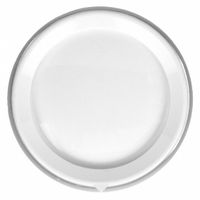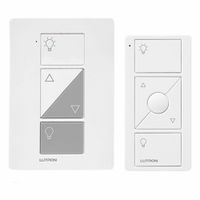Call +(254) 703 030 000 / 751 483 999 / 721 704 777
- Home
- Lighting
- Lighting Controls
- Lighting Dimmers
.....Read More
Frequently Asked Questions
How do lighting dimmers work?
Lighting dimmers work by adjusting the amount of electrical power delivered to a light bulb, thereby controlling its brightness. The most common type of dimmer switch used today is the TRIAC (Triode for Alternating Current) dimmer.
TRIAC dimmers function by rapidly switching the light circuit on and off. They use a method called "phase-cutting," which involves chopping up the AC voltage waveform. There are two types of phase-cutting: leading-edge and trailing-edge. Leading-edge dimmers cut the front part of the AC waveform, while trailing-edge dimmers cut the back part.
When the dimmer is set to a lower brightness, it delays the point in the AC cycle at which the current is allowed to flow, effectively reducing the power delivered to the bulb. This rapid switching happens many times per second, so the human eye perceives a steady, dimmed light rather than flickering.
For incandescent and halogen bulbs, this method works well because they are resistive loads. However, for LED and CFL bulbs, which are not purely resistive, special dimmers are required. These dimmers are designed to handle the electronic drivers and ballasts in these bulbs, ensuring smooth dimming without flickering or buzzing.
Modern dimmers may also include microcontrollers to provide more precise control and additional features like remote operation, programmable settings, and integration with smart home systems.
Overall, dimmers save energy and extend bulb life by reducing the electrical load, making them a popular choice for both residential and commercial lighting applications.
Can dimmers be used with LED lights?
Yes, dimmers can be used with LED lights, but there are specific considerations to ensure compatibility and optimal performance. Traditional dimmers, designed for incandescent bulbs, may not work effectively with LED lights due to differences in electrical characteristics. LEDs require a constant current, while traditional dimmers often alter the voltage, leading to flickering, buzzing, or limited dimming range.
To use dimmers with LED lights, it's essential to choose LED-compatible dimmers. These dimmers are specifically designed to handle the low wattage and unique electrical requirements of LEDs. Additionally, the LED bulbs themselves must be labeled as "dimmable." Not all LED bulbs are designed to work with dimmers, and using non-dimmable LEDs with a dimmer can cause performance issues or damage the bulb.
When selecting a dimmer, consider the following:
1. **Compatibility**: Ensure both the dimmer and the LED bulbs are compatible. Manufacturers often provide compatibility lists or guidelines.
2. **Load Capacity**: Check the dimmer's load capacity to ensure it can handle the total wattage of the LED bulbs. LED wattage is lower than incandescent, so the dimmer's minimum load requirement should be considered.
3. **Type of Dimmer**: Choose between leading-edge (triac) and trailing-edge (electronic) dimmers. Trailing-edge dimmers are generally more suitable for LEDs, offering smoother dimming and less noise.
4. **Installation**: Proper installation is crucial. If unsure, consult a professional electrician to avoid potential electrical issues.
By selecting the right dimmer and compatible LED bulbs, you can achieve efficient and effective dimming, enhancing the ambiance and energy efficiency of your lighting setup.
What are the benefits of using a dimmer switch?
A dimmer switch offers several benefits that enhance both the functionality and ambiance of a space. Firstly, it provides energy efficiency by allowing users to adjust the brightness of lights, which can lead to reduced electricity consumption and lower utility bills. By dimming lights, less power is used, extending the lifespan of bulbs, particularly with LED and incandescent lights, which can save on replacement costs.
Secondly, dimmer switches contribute to creating a customizable atmosphere. They enable users to set the mood for different occasions, whether it's a bright setting for reading or a softer glow for a romantic dinner. This flexibility enhances the aesthetic appeal of a room and can improve comfort and relaxation.
Additionally, dimmer switches can improve the functionality of a space. In multi-purpose rooms, such as living rooms or kitchens, the ability to adjust lighting levels can accommodate various activities, from cooking to watching TV, without the need for multiple light fixtures.
Moreover, dimmer switches can reduce glare and eye strain, providing a more comfortable visual environment. This is particularly beneficial in workspaces or areas where screens are used, as it can help prevent headaches and improve focus.
Finally, dimmer switches can add value to a home. They are often seen as a modern, desirable feature that can enhance the appeal of a property to potential buyers. The ability to control lighting levels is a convenient and attractive feature that can set a home apart in the real estate market.
Overall, dimmer switches offer practical, aesthetic, and economic advantages, making them a worthwhile investment for any home or business.
How do you install a dimmer switch?
1. **Turn Off Power**: Switch off the circuit breaker for the light you’re working on to ensure safety.
2. **Remove Existing Switch**: Unscrew the cover plate and the screws holding the switch in place. Gently pull the switch out of the wall.
3. **Test for Power**: Use a voltage tester to confirm the power is off by checking the wires.
4. **Disconnect Wires**: Note the wire connections, then disconnect the wires from the old switch. Typically, there are two black wires and a ground wire.
5. **Prepare Dimmer Switch**: If your dimmer has wires, strip about 3/4 inch of insulation from the ends. If it has terminals, ensure they are ready for connection.
6. **Connect Wires**:
- Connect the ground wire from the dimmer to the ground wire in the wall (usually green or bare copper).
- Connect one of the black wires from the dimmer to one of the black wires from the wall.
- Connect the other black wire from the dimmer to the remaining black wire from the wall.
- If your dimmer has a neutral wire (usually white), connect it to the neutral wires in the box.
7. **Secure Connections**: Use wire nuts to secure the connections and wrap them with electrical tape for added safety.
8. **Install Dimmer**: Carefully tuck the wires back into the electrical box. Screw the dimmer switch into place.
9. **Attach Cover Plate**: Install the new cover plate that came with the dimmer switch.
10. **Restore Power**: Turn the circuit breaker back on.
11. **Test Dimmer**: Turn on the light and adjust the dimmer to ensure it functions correctly.
Are smart dimmers compatible with all smart home systems?
Smart dimmers are not universally compatible with all smart home systems. Compatibility depends on several factors, including the communication protocol, the smart home ecosystem, and the specific features of the dimmer.
1. **Communication Protocols**: Smart dimmers use various communication protocols such as Wi-Fi, Zigbee, Z-Wave, or Bluetooth. A smart home system must support the same protocol for the dimmer to be compatible. For instance, a Zigbee-based smart dimmer will not work with a system that only supports Z-Wave.
2. **Smart Home Ecosystems**: Different smart home ecosystems, like Amazon Alexa, Google Home, Apple HomeKit, or Samsung SmartThings, have specific requirements for device compatibility. A smart dimmer must be designed to work with the particular ecosystem's app and voice assistant. Some dimmers are compatible with multiple ecosystems, while others are limited to one.
3. **Hub Requirements**: Some smart dimmers require a hub to connect to a smart home system, while others can connect directly via Wi-Fi. If a hub is needed, it must be compatible with both the dimmer and the smart home system.
4. **Feature Compatibility**: Even if a smart dimmer is technically compatible, not all features may be supported across different systems. For example, advanced features like scene setting or energy monitoring might only be available in certain ecosystems.
5. **Firmware and Updates**: Compatibility can also be affected by firmware updates. Manufacturers may release updates that enhance compatibility or introduce new features, but these updates need to be supported by the smart home system.
In summary, while many smart dimmers are designed to be versatile, it is essential to verify compatibility with your specific smart home system and its requirements before purchasing.
Do dimmer switches save energy?
Yes, dimmer switches can save energy. They work by reducing the amount of electrical power sent to the light bulb, which in turn lowers the light output. Traditional dimmers achieve this by cutting the voltage waveform, effectively reducing the power consumption. This results in less energy being used compared to a light operating at full brightness.
The energy savings depend on the type of bulb and dimmer used. Incandescent and halogen bulbs, when dimmed, consume less power and produce less heat, leading to energy savings. However, the savings are not directly proportional to the reduction in light output due to the inefficiency of these bulbs.
For LED and CFL bulbs, the situation is slightly different. These bulbs are more energy-efficient and require compatible dimmers to function correctly. When dimmed, they use less power, and the energy savings are more significant compared to incandescent bulbs. However, not all LED and CFL bulbs are dimmable, so it's essential to ensure compatibility.
In addition to energy savings, dimmer switches can extend the lifespan of bulbs by reducing the stress on the filament or electronic components, leading to fewer replacements and additional cost savings over time.
Overall, while dimmer switches do save energy, the extent of savings varies based on the type of lighting and dimmer technology used. For maximum efficiency, it's advisable to use dimmable LED bulbs with compatible dimmers.
What is the difference between a standard dimmer and a smart dimmer?
A standard dimmer is a manual device that adjusts the brightness of a light by varying the voltage or current flowing to the light fixture. It typically involves a physical knob or slider that the user manipulates to increase or decrease light intensity. Standard dimmers are straightforward, requiring no additional technology or connectivity, and are generally less expensive. They are compatible with incandescent and some halogen bulbs but may not work well with LEDs or CFLs without flickering or buzzing.
A smart dimmer, on the other hand, integrates with home automation systems and can be controlled remotely via a smartphone app, voice commands, or through a smart home hub. Smart dimmers often connect to Wi-Fi, Bluetooth, or Zigbee networks, allowing users to schedule lighting changes, set scenes, or automate lighting based on time of day or occupancy. They are designed to work with a broader range of bulb types, including LEDs and CFLs, and often include features like energy monitoring and compatibility with virtual assistants like Amazon Alexa, Google Assistant, or Apple HomeKit.
The primary differences lie in control and connectivity. While standard dimmers require manual operation, smart dimmers offer convenience and flexibility through remote and automated control. Smart dimmers also provide integration with other smart home devices, enabling more complex home automation scenarios. However, they are typically more expensive and may require a neutral wire for installation, which can be a limitation in older homes.



